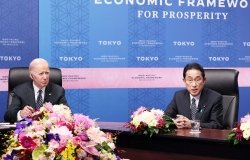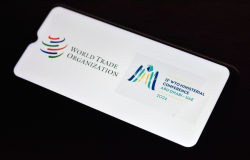2013 Tax Reform Proposal in Mexico: A New Chapter of a Never-Ending Reform Process
In this Expert Take, Daniel Alvarez-Estrada considers Mexico's latest tax reform proposal. He discusses the country's historically weak tax system, analyzes the current proposal, and concludes that there are reasons to believe the Mexican tax system is on the verge of a major overhaul.

The tax system prevailing in Mexico is the result of a long and unfinished process of reform. During the last three decades, the tax system has been subject to a series of overhauls aimed at efficiency, competitiveness, and revenue goals as the Mexican economy undertakes transformation. While some of the desired policy objectives have been accomplished, the tax to GDP ratio in Mexico is still insufficient to meet the social and infrastructure financing needs at the outset of the 21st century.
During 1940-1970, tax policy in Mexico was shaped in a very pragmatic way as the economy moved towards the manufacturing and service sectors from traditional non-mineral primary activities. As a result the tax system was integrated by numerous levies on industrial production, natural resources and international trade. Between 1978 and 1980, another important set of tax reforms was introduced, chief among then the substitution of myriad distortive turnover and excise taxes for a modern and broad-based value added tax (VAT). The economic crisis that unfolded in the beginning of the 80s forced the government to introduce a set of compensatory measures to cushion the effect of rampant inflation levels, including the application of a zero rate VAT on certain items and the exemption of food and medicine. The pervasive effects of this revenue erosion measure have lasted for over three decades.
By the end of the 80´s, the tax structure proved insufficient to address new revenue, efficiency and equity goals arising from a new development strategy based on economic openness, deregulation, and privatization. During 1989- 1991 the government embarked on a major overhaul of the tax system, following a strategy based on lower tax rates and a broader tax base, and done in the context of an overall reduction of the cost of capital at the time that Mexico entered into NAFTA with the US and Canada, and joined the OECD.
The severe financial crisis experienced by the Mexican economy at the end of 1994 resulted in a substantial decline of tax revenues as a consequence of shrinking tax bases and a profound credit crunch. As part of an emergency economic package put forth by the government, a set of policy measures – including a VAT general rate increase to 15 from 10 percent – were introduced. Nonetheless, the downward revenue collection tendency was not reverted until 1997.
During the post-crisis period of 1997-2000 and beyond, the tax reform agenda again addressed some of the issues pending after the 1989-1991 overhaul of the tax system. Clearly, its limited capacity to raise public revenue scored high again in the Government priorities. In 1999, the tax-ratio reached only 11.3 percent of GDP, which turns out to be the same level achieved in 1994 before the financial crisis. However, the elections of 1997, which left the ruling party without an absolute majority in the lower house of Congress for the first time in the history of modern Mexico,, inhibited the ability to reach consensus on a revenue enhancing tax reform.
From a broad perspective, the tax reform effort carried out during the 1970- 2000 period showed mixed results. The combination of a reduction of tax rates, the elimination of some unjustified preferential regimes, full integration of income tax for individuals and corporations, the total recognition of inflation effects into tax bases, and rationalization of the indirect taxation structure created a more efficient, fair, and competitive tax system. Nevertheless, those reforms fell short of providing the Mexican Government with an adequate source of non-oil tax revenues to mobilize development resources for growing needs in physical and social infrastructure. As a result, the tax-to-GDP ratio in Mexico stands as one of the lowest in the Western Hemisphere.
The administration of President Peña Nieto has recently proposed to Congress a new set of tax reforms amid a new generation of economic reforms pursued by the newly elected government in an effort to position Mexico as an attractive emerging market on the aftermath of the 2007-2009 global financial crises. From a historical perspective, questions arise as of whether the new reform effort tackles for good the long pending hurdles embedded into the system, or rather proposes yet another ad hoc set of measures.
To begin with, and from a revenue adequacy perspective, the tax reform package expects to enhance the buoyancy of the tax system in the mid and long terms, but is apparently insufficient to take the tax revenue collection in Mexico to average levels in the region. Assuming the tax package is approved by Congress as proposed by the Government, the tax ratio is expected to increase by about 2.9 percent of GDP during 2014-2018, reaching 13 percent of GDP, which is still below the Latin American and the Caribbean average of 15.7 percent of GDP. Despite some of the proposals to increase the VAT on some naturally progressive consumption items, the reform does not address the major weaknesses in the VAT structure. While the general VAT tax rate remains relatively competitive, the revenue productivity by percentage point has been severely undermined to almost half its potential by a widespread application of special treatments, including the zero rating of some goods and services for domestic consumption.
One of the major features of the tax bill is the new paradigm on the taxation of capital in Mexico, which is expected not only to increase the income tax revenue equivalent to one percent of GDP, but more fundamentally it is expected to introduce some progressivity into the tax structure to tackle a lingering uneven distribution of income.
Departing from the policy objective of decreasing the after tax cost of capital to businesses - a vision that has prevailed with tax policy-makers since the implementation of NAFTA back in the mid-90s -, the new income tax legislation contemplates the taxation of dividends and capital gains from the stock market, as well as the elimination of special treatments currently granted to corporations. The proposal also eliminates the prevailing and largely unjustified preferential treatment to business engaged in primary sector activities and reduces the tax benefit granted to maquiladoras. Finally, the personal income tax structure is geared towards a more progressive stance by an increased top marginal rate, and a reduction of personal deductions regressive in nature.
The proposal put forth by the current Administration also tackles simplicity and administration-enhancement policy objectives. On the simplicity side, the tax bill proposes a streamlined income tax legislation with a more transparent legal treatment across economic activities and economic agents. Also, it proposes the elimination of low performance, but compliance-costly tax instruments, such as the single rate business tax (IETU) and the tax on cash deposits (IDE), which were introduced at the outset of the Calderon Administration with the aim of by-passing the political hurdles of proposing a VAT reform. The tax bill also proposes to eliminate the reduced VAT rate currently applicable in the “border” region, applying a uniform tax rate across the country, eliminating current elusion practices engaged by taxpayers with operation in different regions, and easing administrative costs.
Though insufficient to address the Mexican tax system’s longstanding weaknesses, especially in the indirect taxation structure, overall the new tax reform proposal for Mexico looks like a solid step in the right direction from the equity, efficiency, and administrative perspectives. While the tax reform proposal has still to overcome two historical hurdles – the approval by Congress amid a vociferous public debate and the interposition of judicial amparos by large taxpayers - there are reasons to believe the Mexican tax system is on the verge of a major overhaul within its long reform process.
Daniel Alvarez-Estrada is a Senior Public Sector Specialist at the World Bank. The views expressed in this article do not necessary represent those of the World Bank.
About the Author

Mexico Institute
The Mexico Institute seeks to improve understanding, communication, and cooperation between Mexico and the United States by promoting original research, encouraging public discussion, and proposing policy options for enhancing the bilateral relationship. A binational Advisory Board, chaired by Luis Téllez and Earl Anthony Wayne, oversees the work of the Mexico Institute. Read more

Mexico Institute
The Mexico Institute seeks to improve understanding, communication, and cooperation between Mexico and the United States by promoting original research, encouraging public discussion, and proposing policy options for enhancing the bilateral relationship. A binational Advisory Board, chaired by Luis Téllez and Earl Anthony Wayne, oversees the work of the Mexico Institute. Read more










